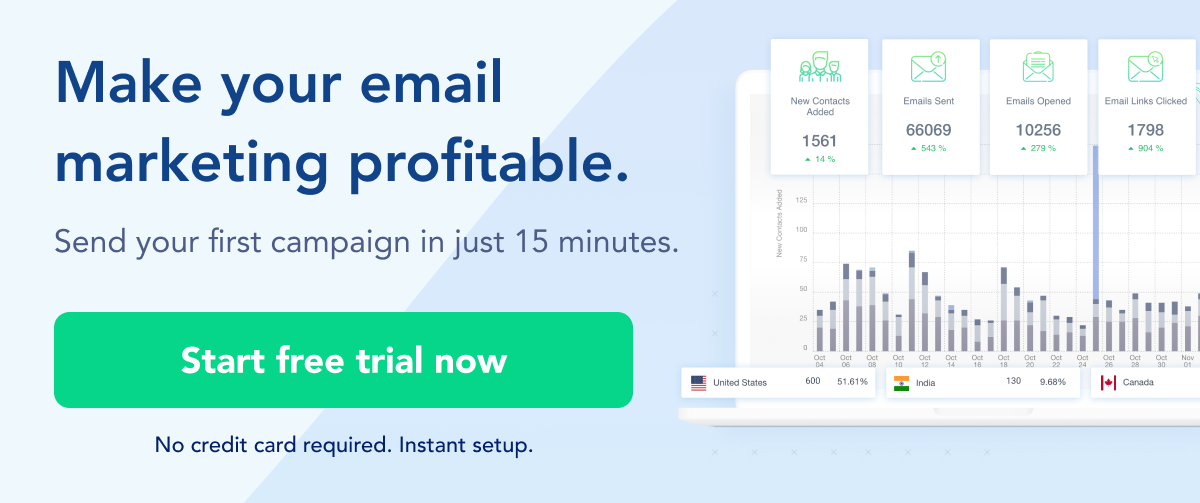
AMP Email 101: Definition, Examples, and Use Cases
While traditional emails have long served as a static medium of communication, AMP (Accelerated Mobile Pages) for email is transforming these messages into dynamic, interactive, and engaging platforms.
Say goodbye to multiple redirects and user drop-offs. With AMP, processes like form fill-ups can be done directly within the email, providing a smoother user experience.
In this blog, we'll read about what AMP emails are, some of their pros & cons and best practices to keep in mind when you implement AMP emails for your campaigns.
Table of Contents
What are AMP emails?
AMP emails are a form of advanced email technology that allows for real-time interactivity and dynamic content updates directly within the email itself, without the need for recipients to leave their inbox or click on external links.
Derived from the Accelerated Mobile Pages (AMP) project, AMP emails go beyond the static nature of traditional emails by enabling functionalities akin to web pages, enhancing user experience and engagement.
Traditional Emails:
- Static: Once sent, the content doesn’t change.
- One-way communication: You send information, and the reader consumes it. For any action (like filling a form or making a purchase), they’re usually redirected to a website.
AMP Emails:
- Dynamic: Content can update in real-time, even after the email has landed in the recipient's inbox.
- Interactive: Allows readers to take actions—like submitting a form, RSVPing to events, or browsing products—directly within the email, without being redirected elsewhere.
For us email marketers, AMP emails offer a fresh canvas, enabling richer user experiences and potentially higher engagement without leaving the inbox's confines.
Potential Use Cases of AMP emails
AMP emails aren't just a buzzword—they're a game-changer for digital communication. As we shift from traditional to dynamic emailing, here are some practical examples of how AMP emails can be used:
- Ecommerce Product Browsing: Retailers can use AMP emails to allow subscribers to browse multiple products via a carousel within the email. Users can scroll through products, view different colors or sizes, and even add items to their cart without leaving the email.
- Feedback and Surveys: Instead of linking to an external survey page, companies can embed feedback forms directly within AMP emails. This means recipients can rate a product, service, or experience without being redirected to another site.
- Real-time Updates: Event organizers can send out AMP emails that show real-time seat availability or ticket counts. As tickets are sold or seats are filled, the numbers in the email will automatically update for each viewer.
- RSVP and Event Registrations: For event invitations, AMP emails can enable users to RSVP, choose meal preferences, or even view an event schedule—all directly from within the email.
- Live News or Stock Updates: Publishers or financial institutions can provide emails where news headlines or stock prices refresh in real-time, ensuring that recipients always see the latest information when they open the email.
- Interactive Content: AMP emails can feature interactive quizzes, polls, or games. For instance, a brand might include a short quiz about a new product launch, letting users interact and learn more about the product in a fun and engaging way.
Benefits of AMP emails
- Elevated Engagement: AMP emails transform the inbox into an interactive playground. Instead of static messages, you can captivate subscribers with real-time updates, carousels, or forms, making them more likely to engage.
- Reduced Drop-offs: Actions that traditionally required a user to click through to a website can now be done right within the email. This reduces the steps a user has to take, thereby decreasing the chances of drop-offs.
- Fresher Content: With the ability to update content after the email has been sent, your audience always gets the most recent information. Whether it's a price drop or a last-minute event change, your emails stay relevant.
- Enhanced User Experience: AMP emails streamline processes. Users can RSVP to an event, fill out a survey, or browse products without ever leaving their inbox, offering them a smoother and more intuitive experience.
- Better Insights: The interactivity of AMP emails can offer deeper insights into user behavior. Knowing which sections of your email users interact with can help refine future campaigns for better results.
- Stand Out in the Inbox: In an age where everyone is vying for attention, AMP emails provide a fresh, innovative approach. Your brand gets a modern edge, differentiating you from competitors still using traditional email formats.
Cons of AMP emails
Like any technology, AMP emails come with their own set of challenges and considerations. It's essential for marketers to weigh these pros and cons carefully before fully integrating AMP into their email strategy.
Here are some potential cons of using AMP emails:
- Compatibility Issues: Not all email clients support AMP emails. If a significant portion of your audience uses an unsupported email client, they won't experience the dynamic features of AMP, which might lead to inconsistent user experiences.
- Increased Complexity: Designing and developing AMP emails requires a deeper understanding of the technology. There's a steeper learning curve compared to traditional email coding, which might necessitate additional training or hiring specialists.
- Potential for Overuse: The dynamic nature of AMP emails is powerful, but there's a risk of overloading emails with interactivity. This can confuse or overwhelm recipients if not done judiciously.
- Security Concerns: With the capability of running scripts within an email, there are potential security risks. While Google has set guidelines to ensure safety, it's a new area that's still being tested and understood.
- Increased Load Times: Due to their interactive nature, AMP emails can sometimes take longer to load, especially if they contain multiple dynamic elements. This might affect user experience if not optimized properly.
- Limited Analytics Tools: While the technology is advancing, there aren't as many analytics tools specifically designed for AMP emails as there are for traditional emails. This might make it challenging to gather detailed insights initially.
Best Practices for AMP emails
As you embark on your journey with AMP emails, there are some best practices to keep in mind to ensure you're leveraging their potential to the fullest while maintaining a positive user experience.
Always prioritize your audience's email client compatibility. Since not all email clients support AMP, it's crucial to have a graceful fallback to a traditional email format. This ensures that even if a recipient can't view the AMP version, they still receive a meaningful and functional message.
Design with intention. While the allure of interactivity can be tempting, it's essential to use dynamic elements only when they genuinely enhance the user experience. Overloading your email with unnecessary bells and whistles can detract from your core message and overwhelm your recipients. Every interactive element should serve a purpose and add value to your email's content.
Remember that with the freedom of AMP comes the responsibility of security. Always adhere to the guidelines set out for AMP emails to ensure that you're not inadvertently introducing vulnerabilities. Running scripts within an email presents unique security challenges, so staying updated with best practices in this area is key.
Maintaining optimal load times is another essential consideration. While AMP emails can house interactive and dynamic content, if they take too long to load, you risk frustrating your users. Strive for a balance between interactivity and load speed, and always test your emails across different devices and networks.
Always be on the lookout for feedback and track user engagement. This will provide invaluable insights into what's working and what's not, allowing you to refine your approach over time. Just like with traditional emails, A/B testing can be a powerful tool in your arsenal to optimize your AMP emails for the best possible results.
In the evolving landscape of email marketing, AMP emails offer a fresh approach. But as with all tools, their effectiveness hinges on how adeptly they're used. By keeping these best practices in mind, you'll be well on your way to creating compelling, interactive, and impactful email campaigns.
Why Choose SendX for Your Emails?
If you're looking for an email marketing software that doesn't require too much time trying to figure out the platform & instead helps to send your message to your audience, reliably (without hitting the spam folders!), then check out SendX.
SendX is an all-in-one email marketing software that enables you to send campaigns, build your list, and automate your marketing. With any plan, you get unlimited emails, and all the features. No more doing complicated calculations to figure out your budget. Claim your free trial here.
Wrapping Up
As AMP emails gain traction, they could very well become the standard, pushing us to reimagine our strategies and campaigns. With AMP, the inbox transforms into an interactive hub where users can shop, fill out forms, or even participate in polls without ever leaving the email.
With all speculations, there's always an air of uncertainty. While AMP holds immense promise, its widespread adoption depends on various factors, including email client support, user acceptance, and how seamlessly marketers can integrate it into their existing workflows.
The future of email marketing is brimming with potential. With technologies like AMP leading the charge, we're gearing up for an era where emails are more engaging, relevant, and interactive than ever before.



